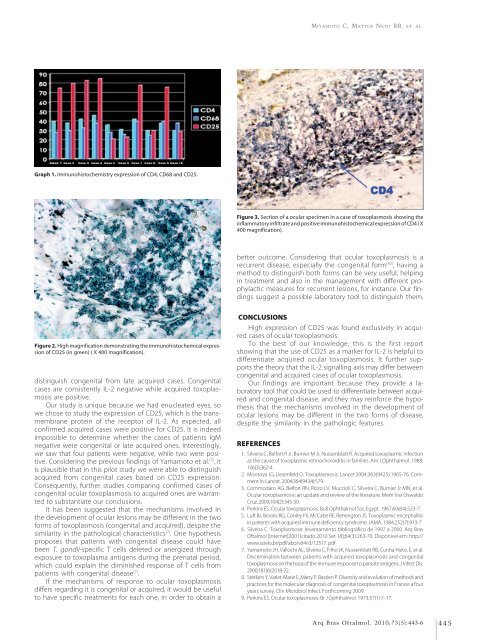Monovision and cataract surgery Visual field and OCT correlation ...
Monovision and cataract surgery Visual field and OCT correlation ...
Monovision and cataract surgery Visual field and OCT correlation ...
You also want an ePaper? Increase the reach of your titles
YUMPU automatically turns print PDFs into web optimized ePapers that Google loves.
MIYAMOTO C, MATTOS NETO RB, ET AL.<br />
Graph 1. Immunohistochemistry expression of CD4, CD68 <strong>and</strong> CD25.<br />
Figure 3. Section of a ocular specimen in a case of toxoplasmosis showing the<br />
inflammatory infiltrate <strong>and</strong> positive immunohistochemical expression of CD4 ( X<br />
400 magnification).<br />
better outcome. Considering that ocular toxoplasmosis is a<br />
recurrent disease, especially the congenital form (30) , having a<br />
method to distinguish both forms can be very useful, helping<br />
in treatment <strong>and</strong> also in the management with different prophylactic<br />
measures for recurrent lesions, for instance. Our findings<br />
suggest a possible laboratory tool to distinguish them.<br />
Figure 2. High magnification demonstrating the immunohistochemical expression<br />
of CD25 (in green) ( X 400 magnification).<br />
distinguish congenital from late acquired cases. Congenital<br />
cases are consistently IL-2 negative while acquired toxoplasmosis<br />
are positive.<br />
Our study is unique because we had enucleated eyes, so<br />
we chose to study the expression of CD25, which is the transmembrane<br />
protein of the receptor of IL-2. As expected, all<br />
confirmed acquired cases were positive for CD25. It is indeed<br />
impossible to determine whether the cases of patients IgM<br />
negative were congenital or late acquired ones. Interestingly,<br />
we saw that four patients were negative, while two were positive.<br />
Considering the previous findings of Yamamoto et al. (7) , it<br />
is plausible that in this pilot study we were able to distinguish<br />
acquired from congenital cases based on CD25 expression.<br />
Consequently, further studies comparing confirmed cases of<br />
congenital ocular toxoplasmosis to acquired ones are warranted<br />
to substantiate our conclusions.<br />
It has been suggested that the mechanisms involved in<br />
the development of ocular lesions may be different in the two<br />
forms of toxoplasmosis (congenital <strong>and</strong> acquired), despite the<br />
similarity in the pathological characteristics (7) . One hypothesis<br />
proposes that patients with congenital disease could have<br />
been T. gondii-specific T cells deleted or anergized through<br />
exposure to toxoplasma antigens during the prenatal period,<br />
which could explain the diminished response of T cells from<br />
patients with congenital disease (7) .<br />
If the mechanisms of response to ocular toxoplasmosis<br />
differs regarding it is congenital or acquired, it would be useful<br />
to have specific treatments for each one, in order to obtain a<br />
CONCLUSIONS<br />
High expression of CD25 was found exclusively in acquired<br />
cases of ocular toxoplasmosis.<br />
To the best of our knowledge, this is the first report<br />
showing that the use of CD25 as a marker for IL-2 is helpful to<br />
differentiate acquired ocular toxoplasmosis. It further supports<br />
the theory that the IL-2 signalling axis may differ between<br />
congenital <strong>and</strong> acquired cases of ocular toxoplasmosis.<br />
Our findings are important because they provide a laboratory<br />
tool that could be used to differentiate between acquired<br />
<strong>and</strong> congenital disease, <strong>and</strong> they may reinforce the hypothesis<br />
that the mechanisms involved in the development of<br />
ocular lesions may be different in the two forms of disease,<br />
despite the similarity in the pathologic features.<br />
REFERENCES<br />
1. Silveira C, Belfort R Jr, Burnier M Jr, Nussenblatt R. Acquired toxoplasmic infection<br />
as the cause of toxoplasmic retinochoroiditis in families. Am J Ophthalmol. 1988;<br />
106(3):362-4.<br />
2. Montoya JG, Liesenfeld O. Toxoplasmosis. Lancet 2004;363(9425):1965-76. Comment<br />
in: Lancet. 2004;364(9434):579.<br />
3. Commodaro AG, Belfort RN, Rizzo LV, Muccioli C, Silveira C, Burnier Jr MN, et al.<br />
Ocular toxoplasmosis: an update <strong>and</strong> review of the literature. Mem Inst Oswaldo<br />
Cruz. 2009;104(2):345-50.<br />
4. Perkins ES. Ocular toxoplasmosis. Bull Ophthalmol Soc Egypt. 1967;60(64):523-7.<br />
5. Luft BJ, Brooks RG, Conley FK, McCabe RE, Remington JS. Toxoplasmic encephalitis<br />
in patients with acquired immune deficiency syndrome. JAMA. 1984;252(7):913-7.<br />
6. Silveira C. Toxoplasmose: levantamento bibliográfico de 1997 a 2000. Arq Bras<br />
Oftalmol [Internet]2001[citado 2010 Set 18];64(3):263-70. Disponivel em: http://<br />
www.scielo.br/pdf/abo/v64n3/12517. pdf<br />
7. Yamamoto JH, Vallochi AL, Silveira C, Filho JK, Nussenblatt RB, Cunha-Neto, E, et al.<br />
Discrimination between patients with acquired toxoplasmosis <strong>and</strong> congenital<br />
toxoplasmosis on the basis of the immune response to parasite antigens. J Infect Dis.<br />
2000;181(6):2018-22.<br />
8. Sterkers Y, Varlet-Marie E, Marty P, Bastien P. Diversity <strong>and</strong> evolution of methods <strong>and</strong><br />
practices for the molecular diagnosis of congenital toxoplasmosis in France: a four<br />
years survey. Clin Microbiol Infect. Forthcoming 2009.<br />
9. Perkins ES. Ocular toxoplasmosis. Br J Ophthalmol. 1973;57(1):1-17.<br />
Arq Bras Oftalmol. 2010;73(5):443-6 445

















